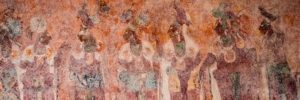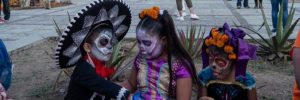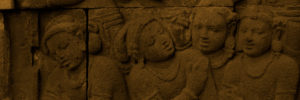What Is The Day Of The Dead?
Mexicans celebrate The Day Of The Dead ( Dia de los Muertos in Spanish ) from midnight of October 31 to November 2 each year. Despite its name the occasion is not viewed in a sombre, or morbid light. Rather it is seen as an opportunity to fondly remember, and honour, the memory of loved ones that have died.
During the festivities Mexican families visit the graves of deceased family members, or friends, to make offerings of food and to decorate them with flowers. Marigolds in particular are associated with The Day Of The Dead since they come into bloom at about the same time of year. A party atmosphere ensues with picnics, music, and often, drinking.
Also during the period of The Day Of The Dead ceremonies, Mexicans assemble elaborate altars, called ofrendas, in their houses as a way of welcoming the spirits of the dead back home.
Not all Day Of The Dead celebrations take place in private. Far from it! This is also a time of spontaneous public parties where costumed celebrants, sometimes accompanied by musicians, parade through the streets. Many locals and tourists alike get their faces painted in skull designs to show their enthusiasm. It’s all very colourful and provides plenty of chances to get some great photos.




















Historic Background Of The Day Of The Dead
Before the Spanish conquest of Mexico in the 16th century the indigenous people buried dead family members immediately next to their homes. It was considered essential to maintain close spiritual ties with deceased kinfolk. This involved making offerings to the spirits of the dead loved ones.
After the Spanish forcefully introduced Christianity to Mexico the Catholic celebrations of All Souls’ Day and All Saints Day were blended with pre-Hispanic religious traditions of honouring the departed and The Day Of The Dead arose.
The religious underpinning of The Day Of The Dead is the belief that the spirits of the dead return to the world of the living for one day each year to spend time with their families. The spirits of babies and children that died prematurely ( these are called angelitos, or “little angels” ) are thought to arrive at midnight on October 31. The angelitos are said to spend all of November 1 in the presence of their families before departing again for the afterlife. Deceased adults return to the material world the following day.
Among the most common type of offerings laid out for the returned spirits are sugar candies in the shape of skulls. These will commonly be decorated with the names of the deceased. A special type of bread called Pan De Muertos ( “Bread Of The Dead” ) is baked and shared during the festival.
The Day Of The Dead And Halloween
Despite being held at the same time of year, and having some similarities, The Day Of The Dead and Halloween are different celebrations. However, due to the fact that many Mexicans have relatives in the USA, Halloween customs have been influencing The Day Of The Dead. I saw many children trick or treating through the streets of Oaxaca with pumpkin-shaped plastic pails. Their hope was that passersby would drop in some candy or loose change.
Oaxaca’s Day Of The Dead For Visitors
As previously mentioned, not all Day Of The Dead celebrations are private family affairs. A very public tradition during the festivities are called comparsas. These are groups of people wearing costumes and skeleton makeup that march through the streets in the day and at night. There are also bands of musicians that parade around. These bands generally play traditional Mexican music. There was always a bass drum and a brass section in the bands that I saw.
The bands and the comparsas are quite informal and you never know when you’ll happen upon them or where they will appear next. There is also always the sound of fireworks both close by and blocks away.
There was never any issues with me taking photos of the partying people. Eager photographers were just another part of the scene. You can’t help getting some good photos with all the costumes and colours on display.
Oaxaca’s Other Charms
Oaxaca is a very beautiful Spanish colonial city with amazing colourful historic buildings throughout the city centre. The streets are clean and there are ample parks with benches for relaxing and people-watching. Oaxaca is also a very safe city. The streets are well lit at night and there’s always plenty of other people, including police on foot patrol, around.
Oaxaca is renowned throughout Mexico for the quality and uniqueness of its cuisine. Also in recent years artisanal Mezcal has really taken off in popularity and Oaxaca has a number of bars where visitors can sample this genuinely Mexican tipple. I sampled several brands and found that there is a wide variation in flavours from one distillery to another. I also enjoyed some fabulously delicious meals while in Oaxaca.
The history of Oaxaca stretches back thousands of years. More than 2,500 years ago the Zapotec civilization was one of the first to develop in the New World. The ancient sites of Mitla and Monte Alban are easy to reach from Oaxaca and are fascinating to visit. The Zapotec language lives on among the indigenous people today. Actually, several other indigenous languages are still spoken in Oaxaca. Some of the indigenous villages near Oaxaca are centres of handicraft production. It’s possible to visit these places. The quality of the handicrafts produced in Oaxaca is generally quite high but the prices are very reasonable.
Further afield on the Pacific coast of Oaxaca state are some great beaches at places like Puerto Escondido and Manzanillo. Personally I was more interested in Oaxaca’s cultural attractions than beach resorts so I avoided the Pacific coast.
So even without The Day Of The Dead Oaxaca has plenty to offer to visitors.




